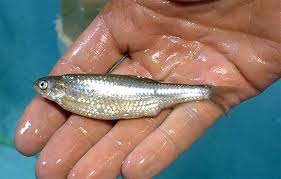Fishermen who use minnows to bait don’t have to show a receipt for proof of purchase anymore.
The Department of Natural Resources used to require anyone fishing with minnows to keep the receipts.
The law was in place to fight a fish-killing disease called viral hemorrhagic septicemia, or VHS.
The disease was found in the Great Lakes in 2005.
The DNR says the receipt requirement can be dropped because most anglers know about the risks of fishing with live fish bait.
There was nothing simple or humble about the receipts that were involved. Retailers who sell minnows are required to document how many and what kind of baitfish were sold, whether they were certified VHS-free, the date, place of purchase and in which VHS management unit the bait could be used.
Anglers were required to hold onto their minnow pedigrees to prove they were using the right minnows in the right place, and were required to destroy the bait when the sales receipt expired.
For sporting goods shops, selling a pistol might have been less complicated.
But it worked. Anglers learned the risks associated with live bait use. They’re conservationists; there is nobody more invested in protecting our resources than hunters and anglers.
“The current regulations have been in effect for several years and the department believes that the retail receipt provision can now be removed because anglers are more knowledgeable about the risks associated with bait use,” the department wrote in its proposed order. The Natural Resources Commission was expected to approve the order Thursday.
“Several years” is how long the Army Corps of Engineers has been trying to figure out how to keep a different pestilence out of the Great Lakes.
Jan. 13, 2014
The Department of Natural Resources (DNR) would like to inform anglers about new viral hemorrhagic septicemia (VHS) regulations that went into effect Thursday, Jan. 9. The changes result in simpler regulations for anglers who purchase and use minnows as bait by removing the retail sales receipt provision. Anglers will now no longer be required to possess their bait receipts while fishing and retail minnow sellers will no longer be required to provide anglers with detailed receipts for minnows.
VHS is a serious viral disease that has spread into the Great Lakes region and caused large-scale fish kills. VHS was first identified in the Great Lakes in 2005 and has caused mortalities in a number of fish species in the Michigan waters of Lake Huron, Lake St. Clair, St. Clair and Detroit rivers, Lake Erie, and inland in Budd Lake near Harrison and Base Line Lake near Pinckney. It has also been found in Lake Michigan waters of Wisconsin. The DNR actively monitors for VHS throughout the year and as other areas are identified positive for VHS, they will be listed online at www.michigan.gov/vhs.
Receipts were previously used for educational and enforcement purposes to direct anglers to places where their bait could be used based on purchase location and whether or not it was certified as disease-free. VHS regulations have been in effect for several years and, after careful review, the DNR determined the retail receipt provision could be removed because anglers are more knowledgeable about the risks associated with baitfish use.
There is no known treatment for VHS, so preventing the spread of disease is the best way to protect Michigan’s fish. Anglers can help prevent the spread of VHS by keeping the following tips in mind when using baitfish:
Learn to identify the species of baitfish you are using. Species known to be susceptible to VHS and typically used as live bait include emerald shiners, spottail shiners and white suckers. Other species occasionally used as bait that are susceptible to VHS include bluntnose minnows, trout perch, gizzard shad, shorthead redhorse and silver redhorse.
Request that your local bait store sell certified disease-free baitfish.
Purchase and use only certified disease-free baitfish.
Never move live fish between bodies of water.
Disinfect your bait bucket, livewells and bilges between uses with a bleach solution (half-cup of bleach to 5 gallons of water) or allow equipment to dry thoroughly before using in a different body of water.
Properly dispose of all bait containers including worms and soil, crayfish and minnows in a trash receptacle.
Protecting Michigan’s world-class water resources is everyone’s responsibility for now and future generations. All boaters need to drain their livewell(s) and bilge of their boat upon leaving the waterbody because it’s the law.

